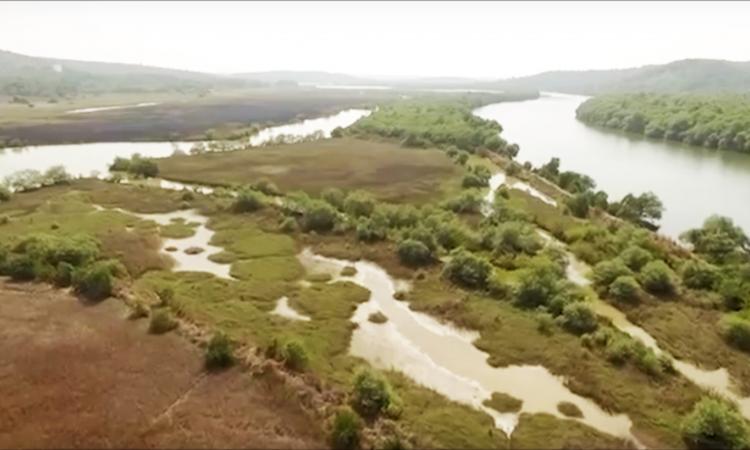
Located just 5 km away from the capital city of Panaji, Chorao island, along the Mandovi river, is one of the largest islands in Goa. The island has a unique ecosystem that is different from the other sanctuaries in the state. The Chorao island in Mandovi is one of the best mangrove forests and houses most of the mangrove species found in Goa.
The island houses the well known Dr Salim Ali bird sanctuary which features a dense mangrove vegetation and is home to some 140 species of birds including heron, kingfisher, white-bellied sea eagle and black eagle. Marsh crocodiles, foxes, jackals, otters, bulbous-headed mudskippers are some of the other sightings in the area. The island of Chorao is also known for its traditional eco-friendly production systems known as the Khazan lands--a paddy-cum-fish culture system--which provides a healthy diet of both grains and proteins to the local community.
In 2014, a Coastal and Marine Protected Area (CMPA) project was initiated jointly by Deutsche Gesellschaft für Internationale Zusammenarbeit (GIZ), a German organisation and a service provider working on sustainable solutions and services and the Goa forest department. The primary objective of setting up this project in Chorao is to assess the rich biodiversity of the island.
By involving the island community, the project seeks to create an environmental and economic balance for this ecosystem and its people. The project strives to contribute to conservation and sustainable use of biodiversity in selected areas along the coast of India which will ultimately benefit the local population depending on the healthy marine and coastal ecosystems.
To achieve its results, the project takes three major approaches:
1. Development and implementation of participatory processes for the conservation and the management of natural resources in designated areas along the Indian coast.
2. Facilitating capacity development of key sectors and stakeholders crucial for the management of the coastal and marine biodiversity and protected areas. To ensure their sustainability, the measures are implemented together with partners at the national and state levels.
3. Facilitating a dedicated information, education, and communication programme to sensitise key stakeholders for the conservation of coastal and marine biodiversity and ecosystem services.
Chorao is not just a habitat for the unique coastal biodiversity but also a learning centre that showcases the unique biodiversity of mangroves and the services they confer. “The island was chosen to be the site for the project implementation because of the unique socioecological history of the island along with the rich biodiversity and many people-led sustainable initiatives such as the Chorao farmers club,” says Aaron Lobo, renowned marine ecologist and the Technical Advisor for the GIZ.
The CMPA Project is commissioned by the German Federal Ministry for Environment, Nature Conservation, Building and Nuclear Safety (BMUB), under the International Climate Initiative (IKI). It is implemented by the Ministry of Environment, Forest and Climate Change (MoEFCC), Government of India, and GIZ GmbH on behalf of BMUB. Chintan Gohil-The Source Project produces the film.
This film “Chorao Island: A Place, its People and a Project” was made under the project titled ‘Conservation and Sustainable Management of Coastal and Marine Protected Areas (CMPA)’ of the Indo-German Biodiversity Programme.
GIZ disclaimer: The views expressed in this video are those who were a part of the study and may not in any circumstances be regarded as stating an official position of the Ministry of Environment, Forest and Climate Change (MoEFCC) or GIZ. The designation of geographical entities in these videos, and presentation of content do not imply the expression of any opinion whatsoever on the part of MoEFCC or GIZ, concerning the legal status of any country, territory, or area, or of its authorities, or concerning the delimitation of its frontiers and boundaries.
Disclaimer: The views and opinions expressed in these videos are those of the people/organisation(s) that made them and do not necessarily reflect the policy or position of India Water Portal.